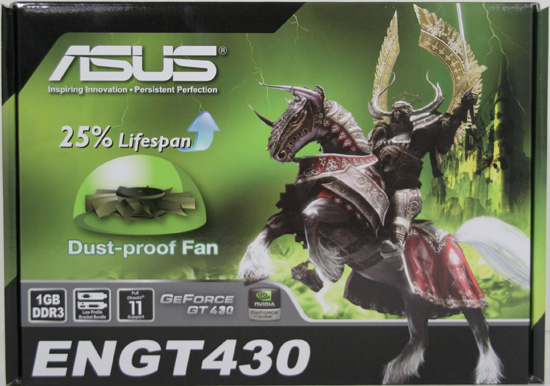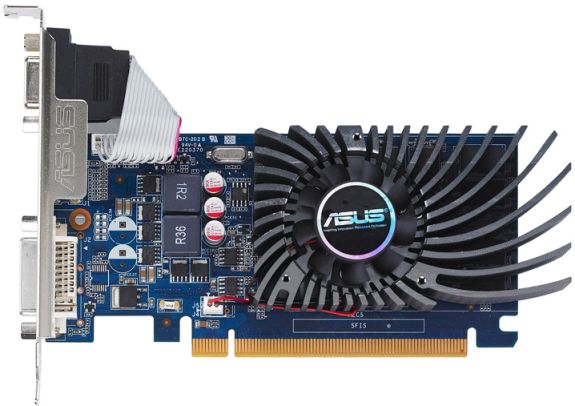NVIDIA's GeForce GT 430: The Next HTPC King?
by Ryan Smith & Ganesh T S on October 11, 2010 9:00 AM ESTMeet the Asus ENGT430
For our look today at the GT 430, Asus graciously provided us with their GT 430 card, the ENGT430. As with all the other cards being released it’s a custom design, featuring the usual Asus design elements: a double-sealed fan, fuse protection, and - while we have a hard time believing this is an issue on such a small card – GPU guard PCB reinforcement.
For this card Asus is very specifically going after the HTPC market. The ENGT430 is a half-height card with a low-profile bracket included, and for cooling it uses a decently sized heatsink with a particularly tiny fan we measure at 36mm. The heatsink does stick up some, so the card is explicitly a double-slot card and you’ll want to make sure you have space for it.
As is the case with low-end cards, reference clocks don’t tend to mean much. While the GT 430 has a reference speed of 700MHz for the core and 1.8GHz effective for the DDR3 memory, Asus has gone ahead and clocked the card at 1.6GHz for the memory. The card is equipped with 8 800MHz (1.6GHz effective) Hynix DDR3 memory modules running in 16bit mode, which is why the card is clocked below NVIDIA’s reference clocks. We expect to see memory clocks all over the place with the launch cards, depending particularly on who could get the best deal on what speed grade of DDR3 RAM for these cards. Given that GT 430 is likely already a memory bandwidth challenged card, this will have an impact, although we don’t have the means to measure it (our card would only go to 1.75GHz on the RAM).

For ports Asus is going with what’s undoubtedly going to be the universal configuration for low-profile GT430 cards: 1x DVI, 1x HDMI, and 1 VGA port. The DVI port is necessary for monitors (without resorting to a dongle), the HDMI port is necessary for HTPC roles, and the VGA port being an easy addition as an optional 3rd port due to its analog nature. GF108 can only drive 2 monitors at once, so the usual restrictions apply.
As is common for budget cards, there’s little else besides the card in the box. Asus includes the low-profile bracket, a multilingual quick installation guide, and a driver CD. This is the first Asus card we’ve reviewed for some time without voltage tweaking capabilities, so even NVIDIA’s integrated overclocking utility is enough for the task.












120 Comments
View All Comments
Stuka87 - Monday, October 11, 2010 - link
The software they used in HQV 2.0 (Which they clearly state).And the software does not do all the processing. It only does the processing if there is no GPU to offload it too (ie: Very CPU intensive).
The GPU's drivers have a LOT to do with the image quality.
ganeshts - Monday, October 11, 2010 - link
Sorry guys, could have been more clear in the testbed setup. I will update the piece accordingly.Anyways, we use Cyberlink PowerDVD build 2113 with TrueTheater disabled and hardware acceleration enabled for playing back the HQV streams.
Please note that this is the HQV 2.0 benchmark suite, and has been tailored for HD unlike the DVD oriented HQV 1.0 suite.
hmcindie - Tuesday, October 12, 2010 - link
The POINT is to get the image to the screen 100% accurately. Not to enable noise removal (scoring noise removal, "edge enhancement" or anything other "improvements" are extremely dubious)Scoring video resolution after these "improvements" is silly. Some of those deinterlacing tests are also stupid because the only way to score a perfect 5/5 score is to make the drivers detect THAT EXACT scene. An algorithm which is more universal cannot get 5/5. That alone completely negates a lot of HQV tests.
The point of HQV is to make a suite of tests and ONLY products that have been HQV certified will pass them. A lot of those tests are synthetically fabricated especially now with Blurays.
ganeshts - Wednesday, October 13, 2010 - link
Interesting point, and I won't argue against your views (because they may be correct).However, stuff like cadence detection is independent of the stream. You are either capable of 2:2 pulldown or not. It has nothing to do with a particular stream. It is aspects like this which are problematic with the GT430.
MadMan007 - Monday, October 11, 2010 - link
It's a shame NV gave up trying even for mere performance parity. With even 8 ROPs (16 would have been great) and/or GDDR5 this might have been a suitable low-end/older game budget card and possibly a worthy successor to the late great 9600GT. Adding GDDR5 alone won't fix the lack of ROPs though and probably won't make a noticable difference unlike the GT 240 where the GDDR5 variants were notably better. Too bad because a lower-end/older game silent low power draw budget gaming card is exactly what I'd be interested in, and AMD drivers are too quirky for me.smookyolo - Monday, October 11, 2010 - link
I guess you skipped over the part where it said that this is NOT a gaming card?nitrousoxide - Monday, October 11, 2010 - link
We don't need low-end gaming card, neither do we need HTPC card anyway 'cuz Llano Fusion APU will wipe them out. The game is over for nVidia at low-end.ggathagan - Monday, October 11, 2010 - link
Yes, that *was* stated, and then followed by 9 pages of gaming benchmarks.If you're going to state that the card isn't meant for gaming, then don't run game tests and fill the article with gaming benchmarks.
There are 2 only pages discussing HTPC performance.
We all know it's targeted to HTPC, so expand your reporting on that aspect of the card's abilities.
MadMan007 - Monday, October 11, 2010 - link
I guess you skipped over the part where it said that the chip is a step back in terms of graphics-oriented functional units in favor of HTPC features?It's clear this isn't a gaming card, but the potential for making it a passable gaming card that is actually competitive with the going-on-10+-month old lower-end Radeons is what I'm lamenting. I generally prefer NV cards but doing worse than their previous product in this segment (saying it's meant to replace the horrid GT 220 is a joke) is just sad. It's all part of the 'more features, no better price/performance' trend in all but the high-end that's been going on for a year though so whatever..
nitrousoxide - Monday, October 11, 2010 - link
I don't know what's wrong with Mr.Huang, but doesn't he even feel ashamed to bring this c-r-a-p to the market?! The AMD Fusion APU will easily overrun it. There will be no future for nVidia if Huang keeps making such pathetic products. The release of HD6800 is in a few days, the first tests show that HD6850 can beat a GTX460 1GB and HD6870 easily overrun the GTX470 (and probably the incoming 384SP-GF104-GTX475). Once the good days for GTX460 are gone, nVidia will be in total disadvantage.